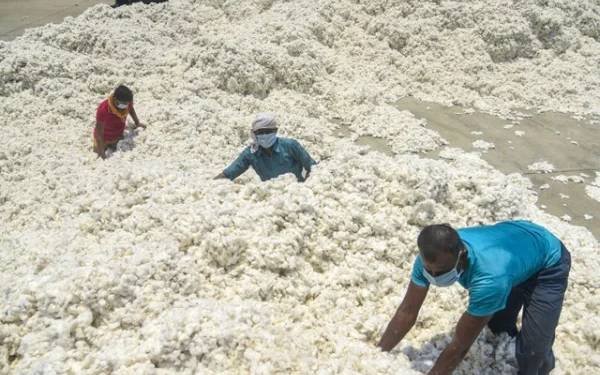Introduction: Cotton Prices Defy Expectations After Budget Measures
KARACHI – Despite the federal government’s imposition of a sales tax on imported cotton and yarn in the 2024–25 budget, domestic cotton prices in Pakistan have failed to show the anticipated upward trend. Contrary to government and industry expectations, market conditions have deteriorated instead of improving, mainly due to adverse weather, declining demand from textile mills, and deteriorating cotton quality.
The Pakistani cotton industry, which has long been under pressure from global competition, climate change, and inconsistent policymaking, now finds itself in another period of uncertainty. While fiscal policies aimed to protect local producers and revitalize the cotton economy, they appear insufficient in the face of deeper structural and environmental challenges.
Sales Tax on Imports: Policy Intentions and Industry Hopes
As part of the 2024–25 federal budget, the government introduced a sales tax on imported cotton and yarn to encourage the use of domestically grown cotton and to boost the struggling local cotton industry. This move was expected to shift demand from international markets to domestic producers, theoretically creating a price support mechanism for local cotton.
The rationale behind the policy was straightforward: by making imports more expensive, local cotton would become more competitive. Farmers, ginners, and other stakeholders hoped this would translate into improved profitability and renewed interest from textile mills.
However, the results have so far been disappointing.
Ground Reality: Prices Continue to Decline Amid Weather Disruptions
Despite these policy changes, cotton prices in Pakistan have fallen rather than risen. According to the Cotton Ginners Forum, the market has experienced an unusual decline. Prices, which previously reached Rs 17,000 per maund, have dropped to Rs 16,600 and in some cases as low as Rs 16,500—a decline of Rs 300 to Rs 400 per maund in just a short span.
This downward trend is largely attributed to recent environmental conditions. In many cotton-growing regions, especially in Sindh and southern Punjab, temperatures soared to over 45°C just two weeks before a spell of heavy rainfall. The combination of extreme heat followed by sudden rains adversely affected the fiber quality, leading to shorter staple lengths and reduced oil content in seed cotton (locally referred to as kapaas).
Ehsan-ul-Haq, Chairman of the Cotton Ginners Forum, said that the dual impact of heatwaves and unseasonal rains has compromised both the quantity and the quality of cotton, discouraging textile mills from purchasing local output.
Textile Mills Show Disinterest in Domestic Cotton
One of the critical drivers behind the stagnant cotton prices is the lukewarm response from the local textile industry. Despite higher duties on imported cotton, many textile mill owners are not rushing to procure domestic cotton. Their hesitation primarily stems from concerns about quality following the recent weather anomalies.
Mill owners, particularly in central and southern Pakistan, are reportedly opting to defer large-scale purchases, waiting to see whether cotton quality improves in the later stages of the picking season. Until then, they are reluctant to commit to buying cotton that fails to meet the quality standards necessary for producing export-grade yarn and fabrics.
This pause in procurement has significantly affected the operations of ginning factories and oil mills, many of which had only recently resumed operations after months of inactivity. Now, due to subdued demand, a number of these facilities are once again shutting down.
Ginners Demand Sales Tax Relief for Cotton Revival
In light of these developments, cotton ginners are now calling on the government to revisit its tax policies. Industry stakeholders argue that if the government genuinely wants to revive Pakistan’s once-thriving cotton sector, it must consider making raw cotton and its by-products entirely sales tax-free.
The Cotton Ginners Forum and other industry representatives have suggested that removing the sales tax from local cotton would reduce operational costs for ginners and make domestic cotton more attractive to buyers. They also contend that tax-free status would improve the cash flow across the supply chain—from growers to ginners and eventually to manufacturers.
According to Ehsan-ul-Haq, the recent taxation policy is well-intentioned but not enough. Without tangible incentives and support mechanisms, the industry will struggle to regain stability.
Cotton Production in Pakistan: A Historical Perspective
Once a major global cotton producer, Pakistan’s cotton industry has seen a consistent decline over the past decade. From a high of 14 million bales in 2014–15, production fell to as low as 6.9 million bales in the 2022–23 season. Contributing factors have included:
- Shrinking cultivated area due to farmers switching to more profitable crops like sugarcane
- Pest attacks, especially from pink bollworm and whiteflies
- Inadequate supply of certified seeds
- Lack of investment in research and development
- Climate-related challenges such as floods, heatwaves, and erratic rainfall patterns
This long-term decline has forced Pakistan to become a net importer of cotton—a position that burdens the economy with additional foreign exchange costs and undermines the domestic value chain.
Future Outlook: Can Cotton Prices Recover?
Despite the current downturn, some experts believe that domestic cotton prices may still improve later in the season. The imposition of the sales tax on imported cotton is expected to curb import volumes in the medium term, eventually redirecting textile mill demand toward local sources—provided the quality issues are resolved.
Moreover, if the government addresses ginners’ tax concerns and supports the supply chain through targeted subsidies, capacity-building programs, and better weather forecasting, the situation may stabilize. The key lies in timely policy execution and coordination between growers, ginners, textile mills, and policymakers.
Conclusion: A Sector at a Crossroads
The failure of cotton prices to rise despite the imposition of a sales tax on imports highlights the complex interplay between policy, climate, and market behavior. While the government’s tax policy aimed to protect local producers, the lack of accompanying support mechanisms and the disruptive impact of climate change have neutralized the expected benefits.
If Pakistan wants to revive its cotton sector—a cornerstone of its agricultural economy and textile exports—it must adopt a holistic strategy. This includes not only fiscal measures but also infrastructural investment, climate resilience planning, and quality control mechanisms.
Without such a comprehensive approach, the cotton sector will continue to face price volatility, production shortfalls, and a lack of confidence among domestic stakeholders.

























